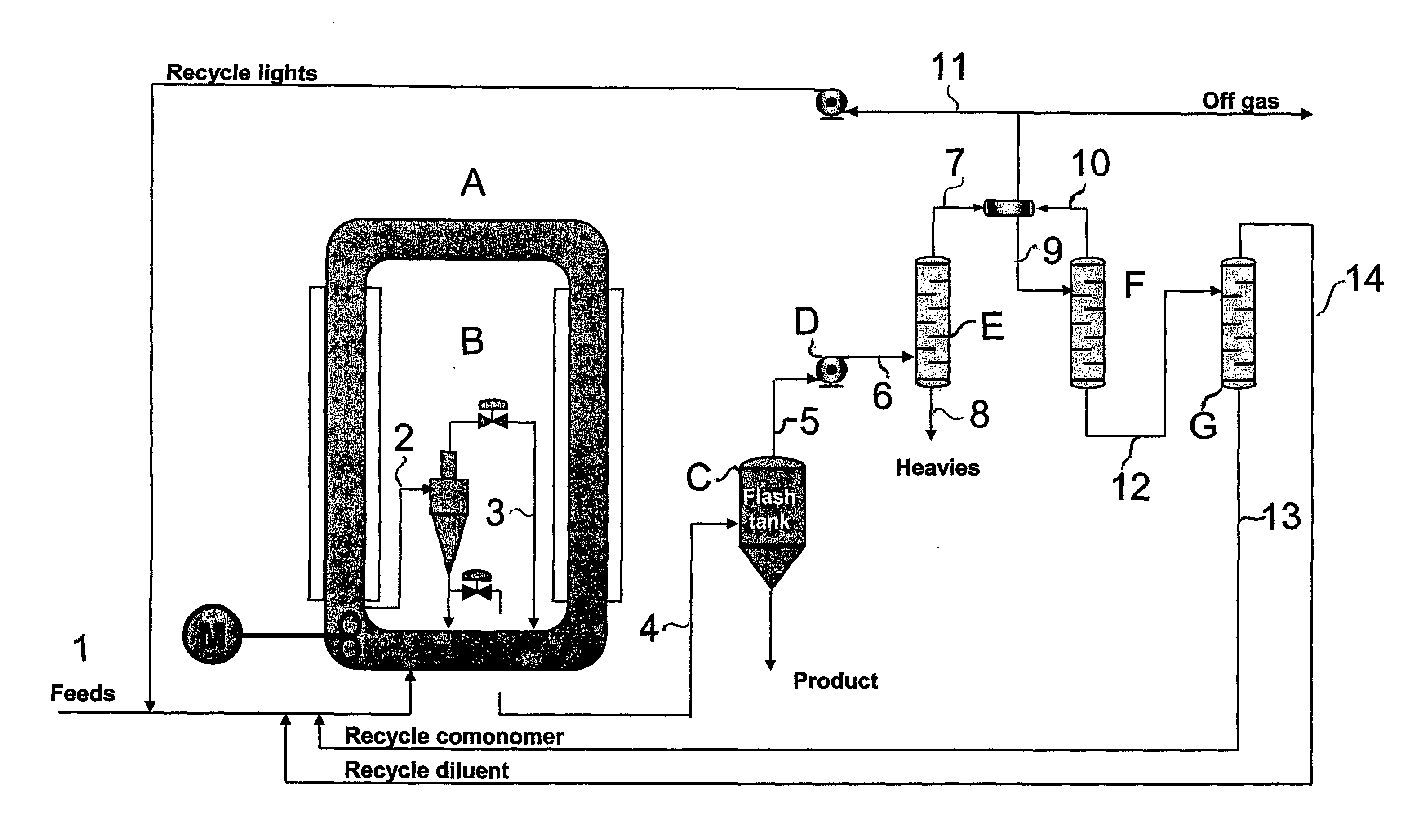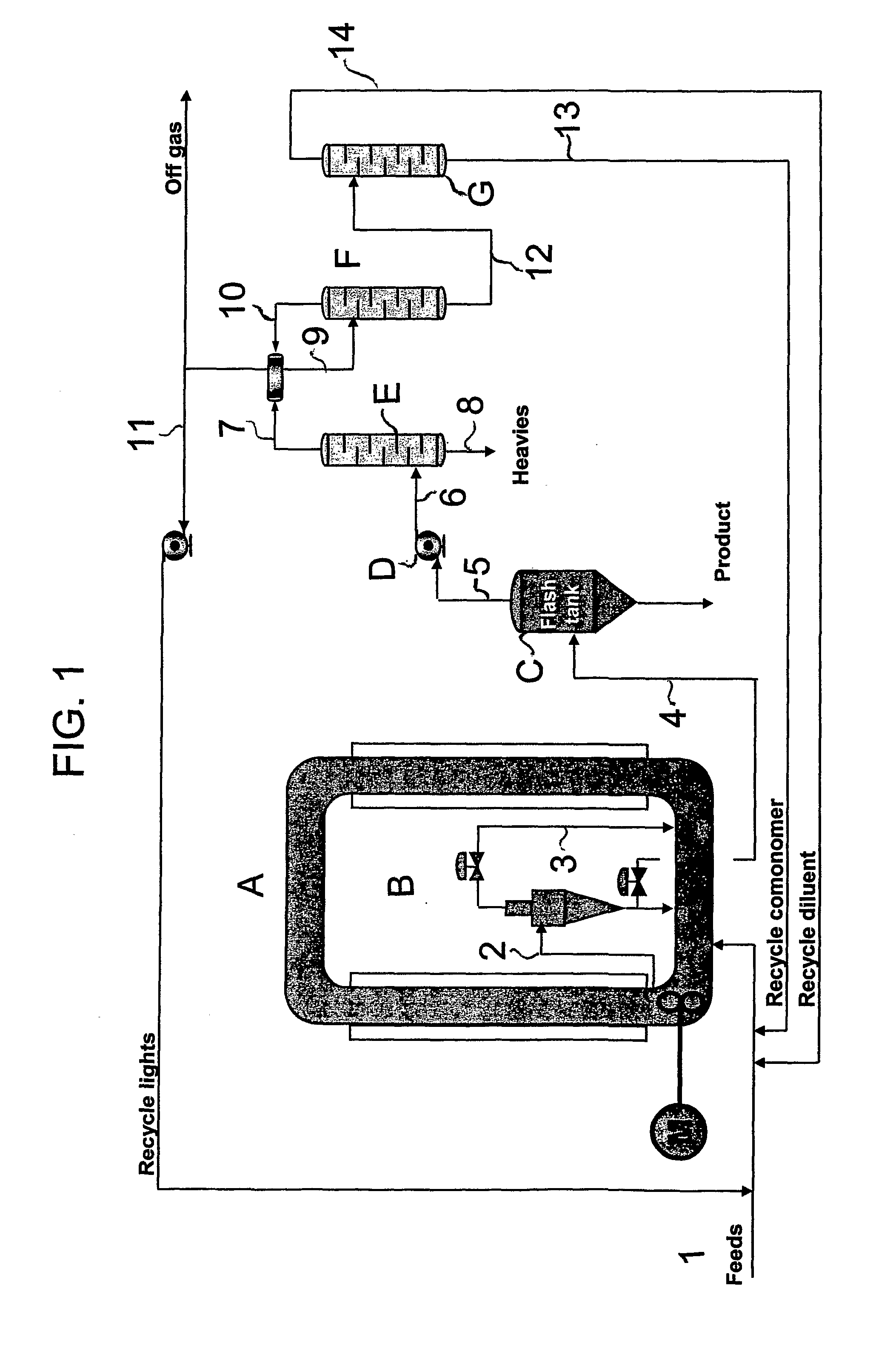Process And Apparatus For Producing Olefin Polymers
a technology of olefin polymerization and process, applied in the field of olefin polymerisation, can solve the problems of unsatisfactory polymerization methods or apparatus, present methods for concentrating the polymer slurry of a loop reactor,
- Summary
- Abstract
- Description
- Claims
- Application Information
AI Technical Summary
Benefits of technology
Problems solved by technology
Method used
Image
Examples
example 1
[0064] A 10 m3 loop reactor is operated at 95° C. and 60 bar pressure with propane diluent. Ethylene homopolymer is produced in the reactor by introducing ethylene, diluent, hydrogen and a polymerisation catalyst, which was prepared according to Example 3 of EP 688794 with the exception that as a carrier material silica having an average particle size of 20 μm is used, in such quantities that the diluent contains 5.9 mol-% of ethylene and 2.6 mol-% hydrogen. The remainder is propane with minor quantities (less than 1 mol-% each) of methane, ethane, isobutane and n-butane. The polymer production is 1.4 tons per hour; the melt index of the polymer is 450 g / 10 min and the density 973 kg / m3 The solids content of the slurry is 25 vol-%.
[0065] The polymer slurry is withdrawn continuously from the reactor through an outlet nozzle and transferred to a hydrocyclone according to FIG. 1. The total slurry feed to the hydrocyclone is 5.5 tons per hour. The product flow is 3.7 tons per hour, wit...
example 2
[0069] Into the reactor of Example 1 is introduced ethylene, 1-butene, hydrogen and diluent, as well as similar catalyst to what was used in Example 1, so that the reaction mixture contains 6.8 mol-% ethylene, 3.1 mol-% 1-butene and 1.8 mol-% hydrogen. Polymerisation temperature is 85° C. The polymer production is 1.2 tons per hour, the melt index of the polymer is 200 g / 10 min and the density 950 kg / m3. The solids content of the slurry is 25 vol-%.
[0070] The polymer slurry is withdrawn continuously from the reactor through an outlet nozzle and transferred to a hydrocyclone according to FIG. 1. The total, slurry feed to the hydrocyclone is 5.2 tons per hour. The product flow is 3.8 tons per hour, with 39 vol-% of solids. The recycle flow is 1.4 tons per hour, with 5.8 vol-% solids. The recycle flow is returned to the loop reactor. The product flow is divided into two streams: The product withdrawal stream is about 1.9 tons per hour and the product recycle stream about 1.8 tons per ...
PUM
| Property | Measurement | Unit |
|---|---|---|
| Fraction | aaaaa | aaaaa |
| Time | aaaaa | aaaaa |
| Fraction | aaaaa | aaaaa |
Abstract
Description
Claims
Application Information
 Login to View More
Login to View More - R&D
- Intellectual Property
- Life Sciences
- Materials
- Tech Scout
- Unparalleled Data Quality
- Higher Quality Content
- 60% Fewer Hallucinations
Browse by: Latest US Patents, China's latest patents, Technical Efficacy Thesaurus, Application Domain, Technology Topic, Popular Technical Reports.
© 2025 PatSnap. All rights reserved.Legal|Privacy policy|Modern Slavery Act Transparency Statement|Sitemap|About US| Contact US: help@patsnap.com


